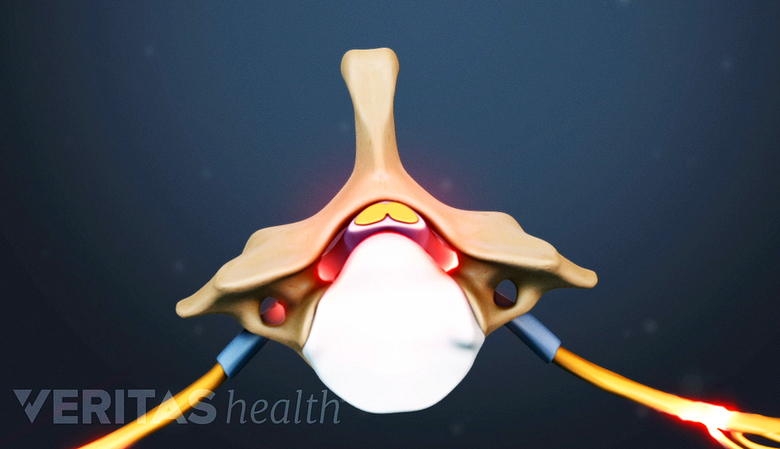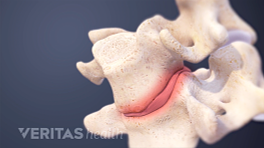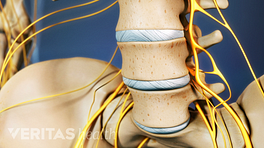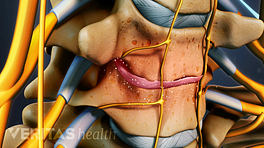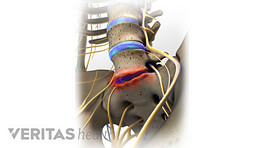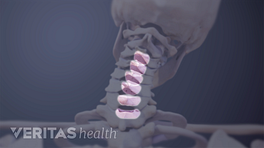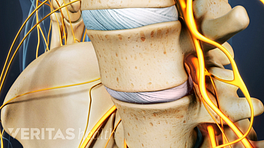Understandably, many patients worry that if they have a lot of low back pain when they are in their thirties or forties, the pain will become much worse as they age.
However, many pain management and rehabilitative options are available for degenerative disc disease. If patients can find a way to manage their back pain and maintain their function, the prognosis is quite favorable.
The long-term progression of disc degeneration involves the inflammatory proteins within the disc space. These proteins eventually burn out, causing the disc to become stiffer and the pain-generating micro-motions to decrease.
In This Article:
- How a Disc Becomes Painful
- The "Degenerative Cascade" of a Degenerating Disc
- Degenerative Disc Disease Progression over Time
- Video: What Is a Degenerative Disc and the Degenerative Cascade?
Long-term Outcomes of Degenerative Disc Disease
Degenerated discs flatten over time and encroach into the spinal canal.
The degenerative process of the spinal disc may start gradually or suddenly, but progresses over 2 to 3 decades from severe and at times even disabling bouts of pain to a state in which the spine is restabilized and the pain is diminished.
Alongside the disc, the joints and the vertebral bones may also be affected by the degenerative process. Supporting muscles, blood vessels, and nerves can also be affected. Aging of the spine may be associated with other degenerative conditions, including 1 Tomé-Bermejo F, Piñera AR, Alvarez L. Osteoporosis and the Management of Spinal Degenerative Disease (II). Arch Bone Jt Surg. 2017;5(6):363-374. :
- Spinal osteoarthritis. Small facet joints can become strained when the disc loses its structure, accelerating the degeneration of the joints.
- Osteoporosis. The degeneration of the bony structure can increase the risk of fractures in the vertebral bones, contributing to overall instability and aging of the spine.
- Spinal stenosis. A narrowed spinal canal can occur as the discs flatten, stiffen, bulge into the canal, or strain the facet joints.
- Degenerative spondylolisthesis. One vertebral body can slip over another, possibly due to degeneration of the facet joints which may be a consequence of disc degeneration.
While degenerative disc disease itself may have a favorable outlook, other degenerating structures can sometimes affect nerves or blood vessels and lead to a variety of pain symptoms.
Spinal Disc Degeneration on MRI Scans
A level of disc degeneration is common by the sixth decade of life and beyond, when risk of pain from a degenerating disc is greatest. 2 Vo NV, Hartman RA, Patil PR, et al. Molecular mechanisms of biological aging in intervertebral discs. J Orthop Res. 2016;34(8):1289-1306. doi:10.1002/jor.23195 Degeneration can also start at a younger age, but pain does not always accompany disc degeneration. In fact, it is common to see degenerated discs on medical imaging in someone who has no spine-related pain.
Magnetic Resonance Imaging, called an MRI scan, has contributed a great deal to our understanding of degenerative disc disease and the natural degenerative process. With the advent of MRI technology, good anatomical detail of the disc can be imaged and correlated with the individual’s pain.
Studies with MRI scans collectively show the likelihood of degeneration with age 3 Brinjikji W, Luetmer PH, Comstock B, et al. Systematic literature review of imaging features of spinal degeneration in asymptomatic populations. AJNR Am J Neuroradiol. 2015;36(4):811-816. doi:10.3174/ajnr.A4173 :
- 37% of pain-free 20-year-olds have disc degeneration
- 96% of pain-free 80-year-olds have disc degeneration
Aging may be related to degeneration of the spine, which is not always a painful process. Health practitioners can determine if spinal disc degeneration on an MRI scan correlates with clinical symptoms of a degenerating spine, such as lower back pain and stiffness in lumbar degenerative disc disease or neck pain and stiffness in cervical degenerative disc disease.
Insights on Living with Degenerative Disc Disease
In the span of 20 to 30 years of degenerative disc disease, decreasingly frequent flare-ups of pain can be managed using exercises, self-care, and additional treatments. Often, these management techniques can also alleviate chronic symptoms of pain within a few months.
- 1 Tomé-Bermejo F, Piñera AR, Alvarez L. Osteoporosis and the Management of Spinal Degenerative Disease (II). Arch Bone Jt Surg. 2017;5(6):363-374.
- 2 Vo NV, Hartman RA, Patil PR, et al. Molecular mechanisms of biological aging in intervertebral discs. J Orthop Res. 2016;34(8):1289-1306. doi:10.1002/jor.23195
- 3 Brinjikji W, Luetmer PH, Comstock B, et al. Systematic literature review of imaging features of spinal degeneration in asymptomatic populations. AJNR Am J Neuroradiol. 2015;36(4):811-816. doi:10.3174/ajnr.A4173

